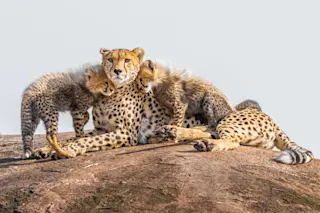Incredible speeds aside, cheetahs spend most of their days resting. They nap the hottest parts of the day away beneath the shade. They chirp and purr to one another but don’t roar. They’re introverts. However, according to the International Union for Conservation of Nature (IUCN), they’re also classified as one of over 40,000 species threatened with extinction,
Specifically, the cheetah, or Acinonyx jubatus, is classified as a vulnerable species. Its global population is declining, and a variety of factors, many human-caused factors, are responsible for this downward trend. Decades-old conservation efforts, however, are in place to reverse this decline and protect the speedy, iconic cheetah.
(Credit:Wayne Marinovich/Shutterstock)
Read more: How Fast Are Cheetahs, and Other Fascinating Facts About the World’s Quickest Cat
When the IUCN classifies a species as vulnerable, it faces a high risk of extinction. According to Our World in Data, researchers quantify extinction when extensive studies of ...















